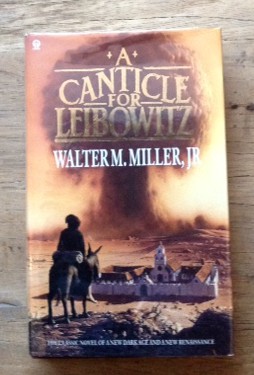Inspiring Older Readers
 posted on 14 Sep 2015
posted on 14 Sep 2015
A Canticle For Leibowitz by Walter M. Miller Jnr
Walter Miller was a regular contributor to the science fiction magazines which were proliferating in the US during the 1950s. A Canticle For Leibowitz which was published in 1960 was itself the product of three separate short stories that had been published at an earlier date and which were extensively revised for the final draft that made up the novel. As a result, it’s hardly surprising that Miller’s book is pretty much always classified as a science fiction classic – but I think that sets up potentially unnecessary barriers in terms of expectations and potential readership. For me, Miller’s book is much better thought of as belonging to the tradition of dystopian fiction that emerged in the post World War Two world as the Cold War began to be shaped. This book is driven by a fear of human annihilation or a return to the Dark Ages that many felt possible in the new Atomic Age.
The three sections of the novel allow us to travel over centuries as the human race recovers from a nuclear catastrophe. Civilisation has been driven back to a version of the Dark Ages where knowledge of the past is seen as dangerous and unlawful. Ironically, evidence of our scientific heritage (almost all of which was destroyed by the great nuclear conflagration) is collected and protected by an order of monks who hold these scarce relics as sacred. This order had been established by a former electrical engineer, Isaac Leibowitz, who survived the nuclear war, converted to Roman Catholicism and was eventually martyred for his role in ‘booklegging’ – illicitly storing remnants of knowledge from printed matter.
In the second book Miller takes us forward towards a new Renaissance. The order has continued to store remnants of knowledge but now we see them being used by the religious hierarchy to aid the building of rudimentary new machines. We see alliances between newly emerging city-states begin to form and the new technologies that are being created allow wars between these states to start up again.
In the third and final part we see that humanity has once again invented nuclear weapons and a space race. Nations struggle for primacy and build weapons in space whilst at the same time denying they are doing it. Inevitably pre-emptive strikes and retaliation lay waste to humanity yet again. Only the sharks survive in the deepest parts of the ocean.
Miller’s message is a depressing one. Humanity is fundamentally unable to learn lessons and is doomed to repeat its past. His view that history (and time?) is in some way cyclical and that we are fated to relive mistakes leaves us no way out.
The book also explores the nature of religious belief and the role it has to play in civilisation; he suggests that the development of secular knowledge will always open the gap between our urge towards the religious and our need for a collective State.
The book is a profound one and profoundly depressing. It is indeed a product of its age but not, I think, bounded by the time in which it was written. Miller’s themes speak to us now and as we ourselves seem to be reliving aspects of the world as it was in the mid-20th century, it’s easy to see how he concluded that we are trapped on a wheel of fire, destined to relive our mistakes.
Terry Potter
September 2015